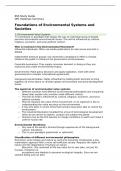Summary
ESS Full Exam Material Summary
- Course
- Institution
- Book
This summary is a complete overview of the ESS SL IB course, completely inline with the 2023 syllabus for ESS SL exams. The summary is divided by unit/chapter for a clear overview. Including graphs and visuals.
[Show more]



